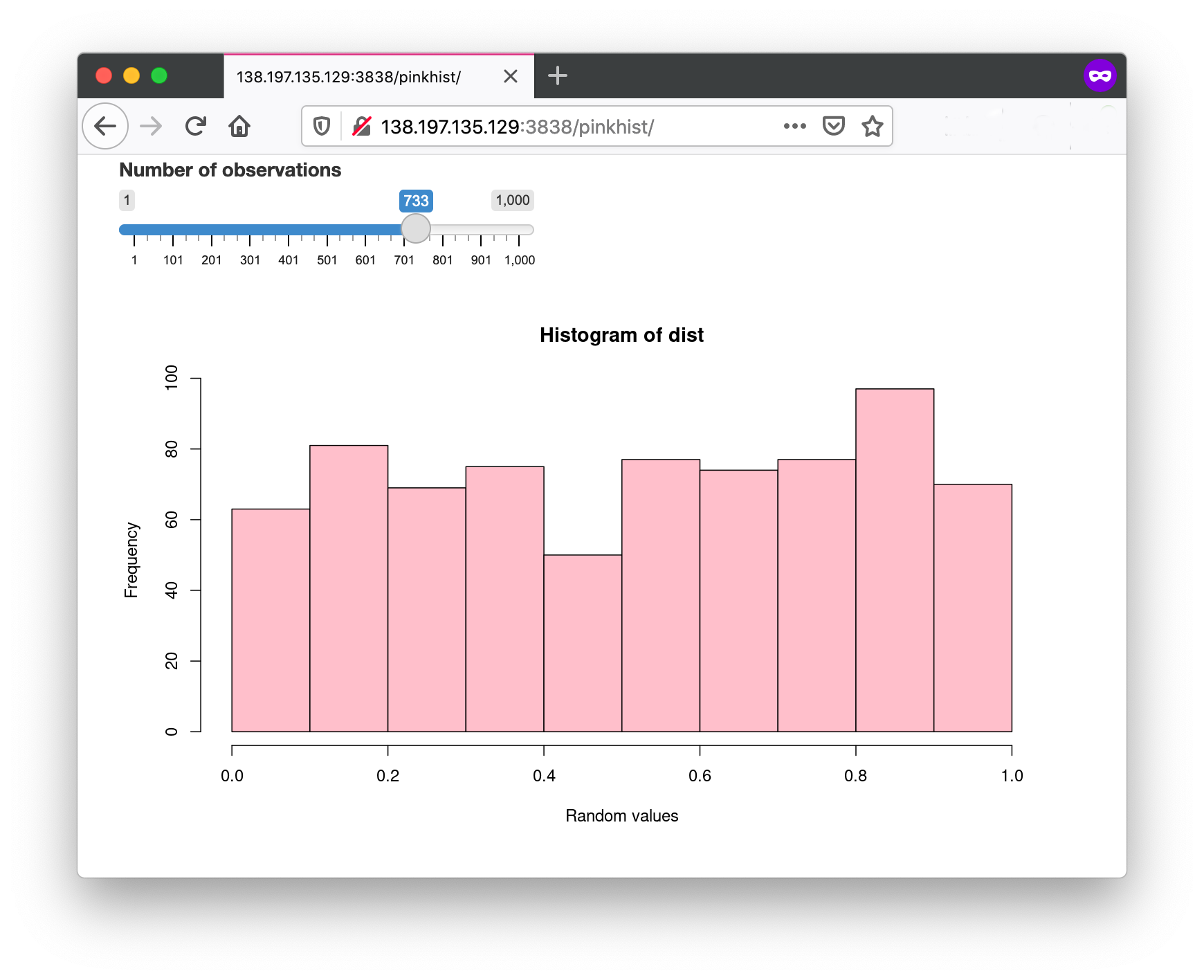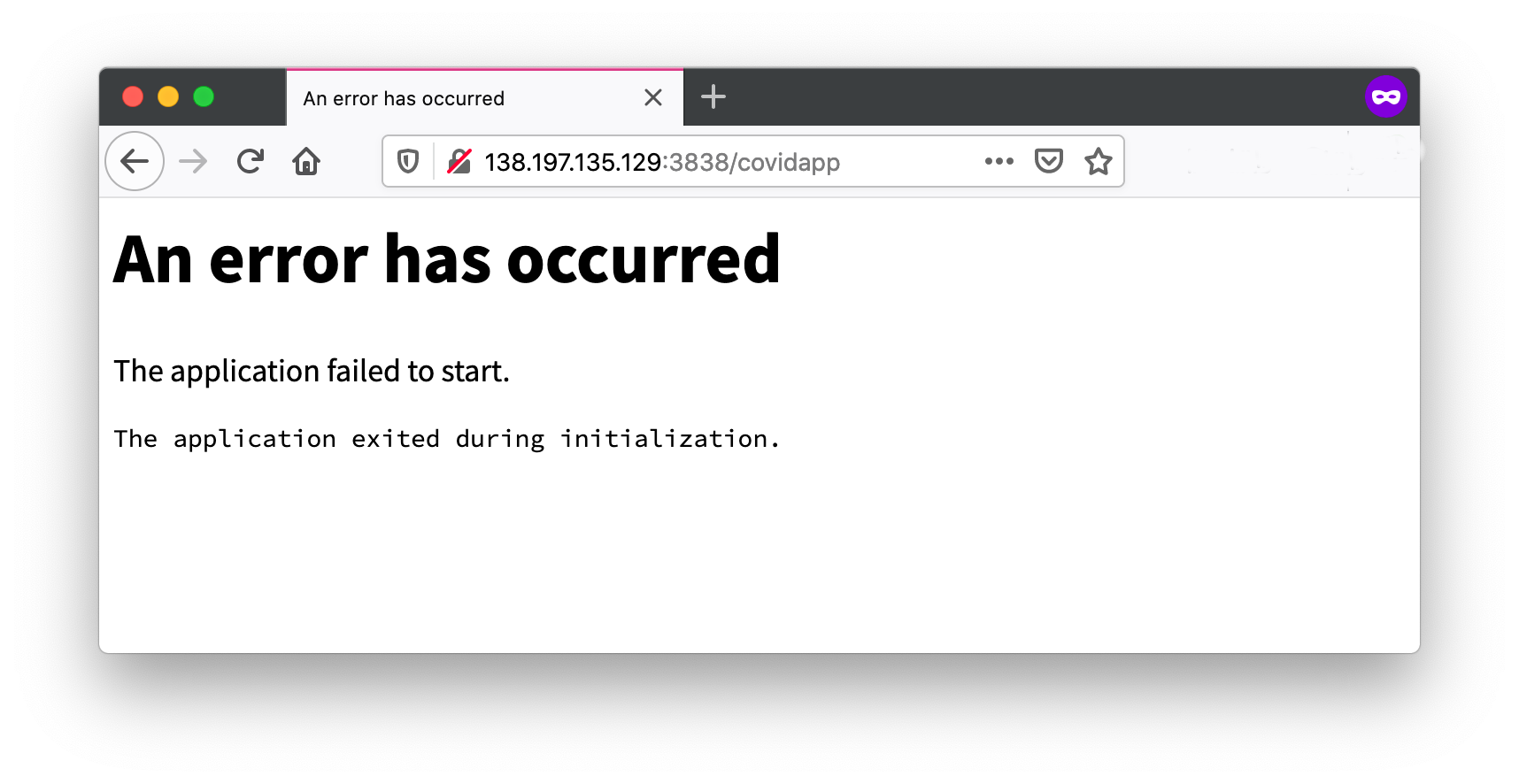The open-source Shiny Server is an easy way to self-host Shiny apps on a low-cost virtual machine. Set up the server yourself or use an existing image and deploy apps in seconds.
Shiny Server is a free and open-source option for self-hosting Shiny apps and it is one of the 3 options listed on the Shiny website. In a previous post, you saw how to secure Shiny Server with a custom domain. Here you will learn how to add and update Shiny apps to your server.
Follow the instructions from the previous post or spin up a brand new virtual machine on DigitalOcean using the RStudio 1-click app in minutes.
The index.html file for the Shiny Server's landing page and the hello and rmd apps are in the /srv/shiny-server/ folder:
$ ls /srv/shiny-server/
index.html sample-apps
$ ls /srv/shiny-server/sample-apps/hello
server.R ui.R
$ ls /srv/shiny-server/sample-apps/rmd
index.RmdThese directories map to the server path as:
http://$HOSTis the landing page (index.html),http://$HOST/sample-apps/hello/is thehelloapp,http://$HOST/sample-apps/rmd/is thermdapp.
$HOST is the custom domain (e.g. yourdomain.com ) your Shiny Server server is using. You can see that the folder structure inside /srv/shiny-server/ directly translates to the server paths. How do you add more apps to the server? Just copy the Shiny apps directly into folders within the /srv/shiny-server/ directory. Here are three options for doing it.

Edit text files on the server
Let's add an app called histogram to the http://$HOST/histogram/ path:
mkdir /srv/shiny-server/histogram
cd /srv/shiny-server/histogram
touch app.R
nano app.R
Copy-paste the Shiny app from below into app.R that you just opened with nano (Ctrl+O to save, Ctrl+X to exit nano):
library(shiny)
ui = fluidPage(
mainPanel(
sliderInput("obs",
"Number of observations",
min = 1,
max = 5000,
value = 100),
plotOutput("distPlot")
)
)
server = function(input, output) {
output$distPlot = renderPlot({
dist = rnorm(input$obs)
hist(dist,
col="purple",
xlab="Random values")
})
}
shinyApp(ui = ui, server = server)
Now if you visit http://$HOST/histogram/ you'll see a range slider controlling sample size and a purple coloured histogram of a Normal distribution that must be familiar from a previous post.
Secure copy the files
You can use scp to copy local files to the server. Let's create a small Shiny app on your local machine. Use the same code as for the purple histogram, but change some of the settings:
mkdir pink
touch pink/app.R
nano pink/app.RCopy this code into the file pink/app.R:
library(shiny)
ui = fluidPage(
mainPanel(
sliderInput("obs",
"Number of observations",
min = 1,
max = 1000,
value = 100),
plotOutput("distPlot")
)
)
server = function(input, output) {
output$distPlot = renderPlot({
dist = runif(input$obs)
hist(dist,
col="pink",
xlab="Random values")
})
}
shinyApp(ui = ui, server = server)The following script copies the local pink directory over to the pinkhist directory of the Shiny Server (this use of scp assumes you access the server using your ssh key pair, otherwise you'll be prompted to provide your username/password):
export APPDIR="pink"
export SHINYDIR="pinkhist"
scp -r $APPDIR root@$HOST:/srv/shiny-server/$SHINYDIR
Visiting the http://$HOST/pinkhist/ address should reveal the new app:

Note that the scp protocol uses port 22 similarly to ssh and sftp. If you are using the non-secure FTP protocol to copy the files, make sure port 21 of your server is open for incoming traffic.
Git based deployment
Set up git so you can work with your public and private repositories (git is already installed, this is a one-time setup for each user):
git config --global user.email "you@example.com"
git config --global user.name "Your Name"
Change to your home directory with cd ~ and run the following script. This will clone the GitHub repository specified in the environment variables, or pull changes if the directory already exists; then makes a directory for Shiny Server if that directory is not already there, then copies the app files ($APPDIR can be empty):
#!/bin/bash
export GITHOST="https://github.com"
export GITUSER="analythium"
export GITREPO="covidapp-shiny"
export APPDIR="02-shiny-app/app"
export SHINYDIR="covidapp"
# clone or pull repo
if [[ ! -e $GITREPO ]]; then
git clone $GITHOST/$GITUSER/$GITREPO.git
else
cd $GITREPO
git pull
cd ..
fi
# make dir if not already there
mkdir -p /srv/shiny-server/$SHINYDIR
# copy repo contents to Shiny Server
cp -rf $GITREPO/$APPDIR/* /srv/shiny-server/$SHINYDIR
You can modify this script for other repositories and save it in a file, e.g. update_covid.sh . Then you can run bash update_covid.sh every time you need the app to be updated. It is also possible to set up a cron job to update the app daily or tie the script to a webhook event triggered by a successful GitHub action.
But before you do any of that, check if the app is running fine at http://$HOST/covidapp/. If all went wrong, you should see this message:

This happened because the Shiny Server setup only included the most basic R packages and we missed the forecast package required by the COVID-19 app. Let's remedy this:
R -q -e "install.packages('forecast')"If you refresh the page now the app should work fine.
This immediately highlights one of the shortcomings of Shiny Server when it comes to continuous integration and delivery (CICD). You need to be extra careful when managing packages, R and package versions, etc. when you have multiple apps with possibly conflicting dependencies. Dockerizing Shiny apps is one solution to isolate your applications.

License
R and the shiny R package are both licensed under the GNU General Public License that permits making a modified version and letting the public access it on a server without ever releasing its source code to the public. However, it is important to note that the open-source version of Shiny Server is licensed under the GNU Affero General Public License (AGPLv3).
AGPL closes the application service provider (ASP) loophole and has a controversial reputation in tech circles, see for example Google's policy on banning the license. We are not providing legal advice on this matter here, merely stating what the license says:
The GNU General Public License permits making a modified version and letting the public access it on a server without ever releasing its source code to the public. The GNU Affero General Public License is designed specifically to ensure that, in such cases, the modified source code becomes available to the community. It requires the operator of a network server to provide the source code of the modified version running there to the users of that server. Therefore, public use of a modified version, on a publicly accessible server, gives the public access to the source code of the modified version. – AGPLv3 Preamble
The interpretation of modified source code and public accessibility on a server leaves a lot of room for interpretation (see some discussions here) which might or might not bother you depending on your intentions and corporate environment. RStudio offers paid exceptions to the AGPL license in the form of RStudio Connect – this model is called dual-licensing (read about it here).
Summary
The open-source Shiny Server is an easy way to self-host Shiny apps on a low-cost virtual machine. You can set up the server yourself or use an existing image and deploy apps in seconds. Some care must be taken with dependencies, so it is good practice to use git or do periodic backups of the server to revert any breaking changes.
If you have followed this tutorial by spinning up your server that you don't need any more, don't forget to destroy the server after you are finished to avoid surprise billing.
Further reading
- The official Shiny Server docs
- Useful tips for logging and user permissions from Dean Attali
- Multiple users managing their apps on the same server
- What’s Open Source Software + How It Makes Money



